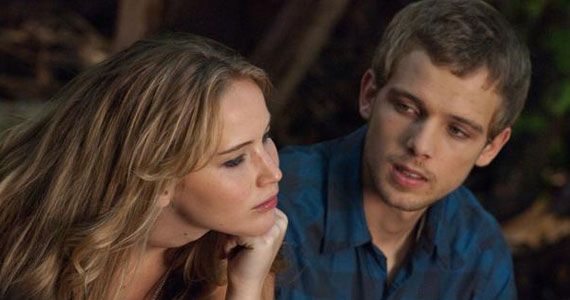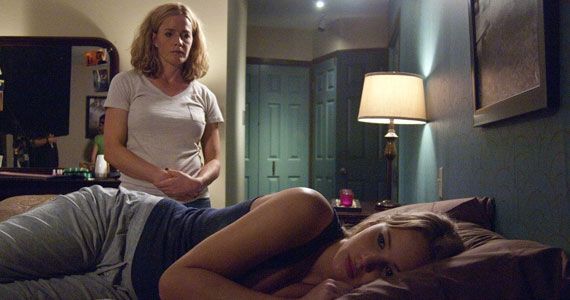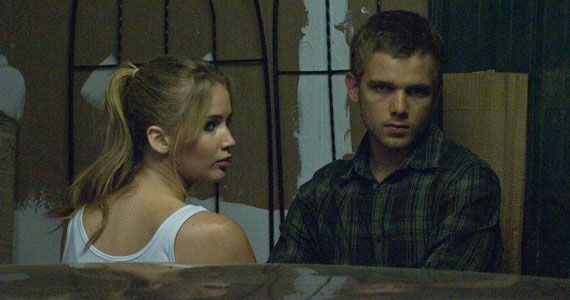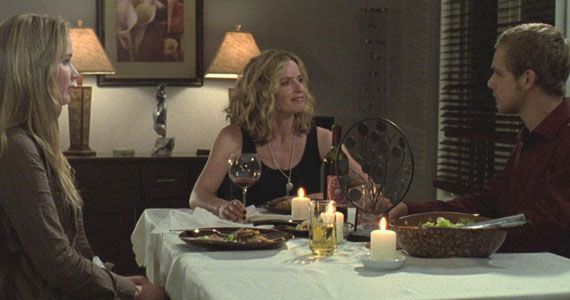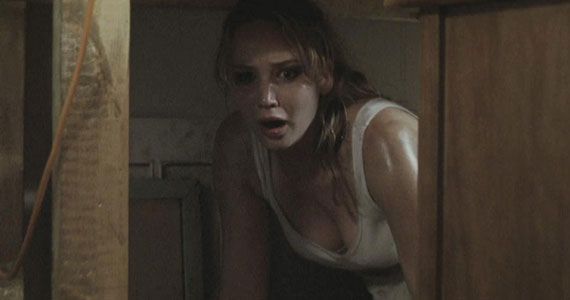Making a horror movie is a double-edged sword. The most hardcore fans of the genre will see anything and everything, so you're guaranteed to make a buck - but at the same time, many moviegoers have seen just about everything and anything, so it takes quite a bit of ingenuity, creativity and thoughtfulness to wow, let alone scare us, and that's the challenge director Mark Tonderai strove to tackle with House at the End of the Street.
Jennifer Lawrence leads as Elissa, a girl who moves into a new house with her mother, Sarah (Elisabeth Shue). Unfortunately, it turns out their dream house has a rather dark past. Just down the street, a young girl viciously murdered her parents and disappeared making her brother, Ryan (Max Thieriot), the only surviving family member. Then again, this isn't such an unfortunate thing for Elissa because Ryan still calls the former crime scene home and he's pretty cute, too.
Sounds like your typical innocent-girl-gets-too-close-to-the-creepy-boy movie, right? That’s actually the point. In fact, that's part of the reason Tonderai was attracted to the project. In honor of House at the End of the Street’s recent DVD and Blu-ray release, Tonderai took the time to explain the meticulous process of turning the expected into the unexpected, delivering a horror thriller with a significant amount of subtext, his experience working with Lawrence, Thieriot and Shue, his reaction to the film’s critical reception and more.
First off, how about that title? There’s a bunch of striking things about it - it’s long, it’s similar to The Last House on the Left, you can abbreviate it using HATES, and it has a horror vibe. Can you tell me about the thought that went into picking it?
Mark Tonderai: First off, I just want to say thank you for seeing it. I got really annoyed with the critical response that we got from it because it was like a lot of the critics were going to the film and looking at it, but they weren't seeing it. It’s a very big difference, you know? There’s a phenomenal amount of detail and thought processes that went into the film. And I’m not saying you should be heralded for that because that’s what everybody does, and I appreciate that. But there’s a sensibility that I feel about the genre that people go and look down on it because it is horror or thriller, whatever you want to call it, and that’s always been one of these things that’s upset me about where the horror genre’s been taken because in my mind, a lot of the films that I've been really blown apart from because of subtext, have come from horror. Rosemary’s Baby, The Exorcist, whatever they might be. So, for me, these films are really smart. People who make the movie are really smart. But also the people involved in them, they wouldn't do it if there wasn't something else going on behind it. You don’t get someone like Jennifer Lawrence doing your film unless she thinks there’s something about it that warrants merit and I think it’s the same thing with Elisabeth Shue.
A little sidebar there, but going back to your question, the title for me is huge. Every single detail of the film is huge. If you look at the t-shirt Jennifer’s wearing when she’s making supper for her mother, it’s the band that her father was in. Filmmaking is detail, and so, for us, those titles are really important and they were done by a friend of mine who works for a company in New York called Trollbäck. Trollbäck’s a big titles company. Big, big, big. They’re very established. My friend Elliot did those and we were very particular about what we wanted to do. One of the things about the film is it’s all effectuality and about the face that we put towards the world and the real face that we have. We wanted to illustrate it in our titles and so he got his four-year-old boy at the time called Zephyr to write the font. That font is actually called Zephyr font because Zephyr did them, and that was what Elliot did. He got his kid to write this font and then we kind of linked them with a more traditional font. What we don’t have is an opening title sequence because I thought that at that point, it would take the audience out of it so what we have is a closing title sequence that is all the details from the film. The opening starts off in black and then it blows to white; that’s my kind of nod of respect to Close Encounters, and then we go into the next sequence of the film which is my nod to Citizen Kane, which is the snow globe. I do it in all my films. Not mimic a shot, but tip my hat to these masters before us. To go from black in a theater into the white, was very much like a teacher beating their ruler on the desk and saying, ‘Okay, people. It’s time to listen now. Stop talking. We're in the film now.'
*
***
* WARNING: PLOT SPOILERS AHEAD *
***
*
Going back to your sidebar, in an industry that’s somewhat drowning in run-of-the-mill horror, what made this stand out?
Stephen King talks about it in Danse Macabre that horror is the incremental sense that something bad is going to happen. I think audiences are smart anyway. I think it’s in our DNA. If you were to do a serial killer film, how are you gonna do it? The serial killer film with heart, the serial killer in a documentary, from the serial killer’s POV - all the different permutations of serial killer films they have seen before so for me, one of the real tricks about my job especially in this genre, is how do I get ahead of audience expectations, because they've seen it. They've seen it 100 times before. This was the issue with the film that some didn't understand. House at the End of the Street is deliberate, right? One guy that got it was the guy from the Village Voice. He wrote a tremendous article about it because he understood exactly what we were trying to do and what we were trying to do was set up the audience and say, ‘Okay, we know it’s a generic title, House at the End of the Street. A boy moves into town? Yeah, we know that.’ So we lure you into this sense of, ‘ I've been there. I've seen this before. There’s nothing new here, right?’ And then suddenly, we take the rug out from under you and say, ‘Actually, all you think about this guy, is not right.
I've been in the cinema when that happens and I've been in the cinema where Ryan breaks the bad guy’s ankle and they cheer and then later, when he gets hit by the hammer, they cheer him for that. And that’s what Hitchcock says you should always do - play the audience like a piano; have them go one way and then have them go the other way. So my job was to make the audience fall in love with Ryan. That was all I was trying to do at the beginning of the film, set up that, make them fall in love with him, make them believe that this guy would live in a house where his parents were killed, make them believe that Elissa would find him interesting, make them believe that he was this wounded, tortured soul, make the audience believe that was really his sister underneath there and then go, actually, no. All the preconceptions that you have about films like this are actually not right.There’s certainly a point in the film where you don’t know which way it’s gonna go and I think that’s pretty scary. [Ryan] is not a psychopath. A psychopath doesn't feel anything for anybody. Ryan felt something for this girl and so he’s got a real high form of psychosis. We did all this work on it to get it really precise about what all of this was. The key scene of the film is the face in the tree scene because you can argue that you fall in love with someone because they see the world a certain way and you don’t see it that way or maybe you find the way that they see it very beautiful, and that’s what he does. When he talks about the face in the tree and how people hide things, you think he’s talking about his sister because he’s talking about something even deeper than that. And then right at the end, when Jen asks the mother, ‘Can you see the face in the tree,’ and the mother can’t, again she’s saying something very specific. She's telling, ‘This boy saw the world in a certain way that is really beautiful and that’s what I felt for him and you, mom, can’t see that, but that’s okay.’ That’s why Jen cries in that scene. That’s the ebbs and the flows of the film that I don’t think the audience might necessarily be able to articulate what I've just said, but I think they feel something and that’s why I think the film has been successful.
Can you tell me more about Jennifer and Max? You kind of hit it big with her and the Hunger Games craze and then, in my opinion, Max is one of the most underrated up and coming actors out there.
I could agree 100% about Max. I think he’s a phenomenal actor. I just did a plot in Vancouver and he was up there shooting, ironically, Bates Motel. He was doing something on tape that I helped him out with and I was, again, just astounded by how good this guy was. With Jen, I’d seen her in Winter’s Bone before I’d left England to come to live in America and do this film, and I said to my agent, ‘That’s the girl that we've got to go for.’ I had a great casting director, John Papsidera. John we got on the film because my producer, Aaron Ryder, produced Memento and produced Prestige, so John did it for us as a favor because we couldn't really afford him if I’m honest. John’s a really great casting director, really precise and really knows his stuff and will argue with you. John backed me up on Jen because nobody knew who she was. We’d just seen Winter’s Bone. And then with Max, they backed me up on Max as well. I really wanted somebody that you could look at and, in their eyes, you could see the hurt there. I called it eastern European. A lot of eastern Europeans have the hurt of the world in their eyes [laughs]. I’m joking obviously, but that’s what I was looking for and he had that. You can get actors that can go there, but when you have somebody who has it naturally, and he had that! But I think when he flips into bad Ryan, there’s a little bit of something else there as well.
***
/END SPOILERS
***
I think the point about all of these characters, all of these people, Max, Jen, Elisabeth, is that they’re really good people. Trust me when I say that. They are really genuinely good people. This is why I think Jen is going to go so far because I think she looks at it like a real honor. I don’t think she takes it for granted. And I think Max is the same. They look at it and go, ‘You know, what we do, we’re really lucky to be doing this and it’s a real blessing to do this.’ And they want to do good work. And Elisabeth Shue, to get her to do the film, Jesus! She really grilled me about the part, what it was and why it was so important. I did this huge document called a bible with everything, all the details, the journeys the characters make, everything, every detail that goes through every department and I remember having to send this to her and just sitting by the phone, waiting to see what she would do because she was the final part of the piece. And that scene, the dinner party scene, wouldn't be the same without Elisabeth Shue's performance. It’s brilliant!”
Their performances are also so heavily reliant on one other. Was there anything you had to do as a director to get them ready for that and then make sure they found the right balance at each stage of the film? I imagine you didn't get to shoot this in order.
No, we didn't I wish we could have. One day I’ll have the money to do something in chronological order, but at the moment I can’t. Let’s be honest; when you’re talking mapping Jen and Elisabeth, you’re talking about two Academy Award nominees, you’re talking about acting that’s probably in the top 5% of the planet. You’re dealing with people that are really, really f***ing good. I think with really good actors, their instincts about how to play a scene or how to play a line are usually really good, they've really got it.
With Jen we did a lot of prep. We did seven or six weeks of prep where I got guitar lessons, we talked about character. We did a lot of prep work, but we don’t touch the script. We just talk about the character and get to know the character. I think you change your mode around for different actors. Some actors want to do a lot of rehearsal work and you can rehearse with them, but some actors don’t want to do that. They want to leave the text alone and keep it fresh for the day and they want to do a lot of character work. Whatever it takes. I think I’m there to facilitate. My job is to make sure on set that they feel so comfortable they can do anything, can try anything because they feel empowered on that set and they feel safe on that set. I don’t stand by the monitors. I stand on set and watch. That, for me, is really important. The relationship with the actors is what the film is about. If you don’t have that, people go, ‘This is just not very good.’
We did a lot of prep. We talked a lot about it so when we got on set, on a schedule that we had, which was very limited, 25 days, you can’t afford to experiment, you can’t afford to get it wrong. It was kind of a little bit of them, a little bit of me, and a little bit of us just, on the day, working it through.
I know this is a testy and personal subject so feel free to take a pass on this, but when I work hard on an article and get a not so nice comment, it can sting pretty hard. How is it for you when this movie does well at the box office, but not as well with critics?
It’s very interesting because as self important as the critics think they are, more important is you. More important is how you feel about your film. It’s funny because me and my friends were arguing the other day about Zero Dark Thirty. I loved it and think it’s a really good film and all my friends are saying they didn't like it. I said, ‘Look, what you have to understand is that I’m looking at it from a director’s point of view and I know as a director you’re under siege, from day one. You’re under siege from people and everybody.’ But you’re more under siege from your own thoughts, your own doubts, and when you make calls like Kathryn [Bigelow] did in that film, like do the end in dark or whatever it might be, it’s a very difficult thing to do, and it’s really difficult to make those sorts of calls when there’s people around you or studios or money or whatever it might be. That doesn't belittle my friends or their argument about Zero Dark Thirty. They could be right, absolutely, but this is an opinion-based medium. Opinions are like assholes; everybody’s got one, so you've got to be very careful about whose opinions you take.
When I have my rough cuts of films, I have my friends who are directors and they’re giving me their opinions, I’m gonna listen to them because these guys know what it’s like to make a film. My point is is that you can’t take a lot of what you read to heart because, frankly, everybody’s a critic now. Everybody’s got a computer, everybody’s got an opinion and they've access to voice that opinion so you can’t really take it to heart. You have to have lines within you. The two things you can only really listen to are, one, what you think of the film, which is really important. The second thing is, if you have the opportunity to meet the fans, which I did the other day, and just talk to your normal cinemagoer and figure out what they think. People are really smart. It’s already part of our DNA and they can tell you whatever it might be. But you can never ever account for people’s opinions. One man’s freedom fight is another’s terrorist. I see blue, you see turquoise. You can’t do that and you can’t make everyone happy.
I always thought the critics were meant to look when they watch a film, to really see the film and see what the filmmaker is doing with subtext, the camerawork, whatever they’re trying to do. But there was a real tertiary kind of laziness about the reviews that I thought, ‘Hang on, mate, it’s like you haven’t seen seen the f***ing film.’ I read one article from one journalist who said I went to a screening and there was a whole lot of critics besides me who were talking how they were gonna rubbish the film, and I was thinking, ‘Hang on, it wasn't my perception of the film. I didn't mind it. I thought it was really quite good.’ And then there’s this kind of attitude that maybe the studio would pull the film back from critics because they were bashing it. That couldn't be further from the truth! Do you know how much money they put into this film and how many screens it went up on? It was just this very weird and lazy interface that happened with the film that I objected to. It wasn't so much what they said, it was just the way that they were interfacing it wasn't right. The way they were seeing it wasn't right.
Going back to you and your article, I have a little boy and one of the things I talk to him a lot about how you can’t control how other people feel about your work. It’s not in your control and you can’t take that to heart. All you can control is the things around you. There are three people I listen to about my films – three! One is my wife. And when they talk to me and they tell me something, I am really affected by it. But everyone else, you can’t because you can’t let it come through. And I’m telling you, as a filmmaker, I promise you I've had to literally say to people, ‘I disagree completely with what you’re saying and we shouldn't be working together on this because it’s wrong and I don’t agree with that,’ and you walk away. I think you have to make that play or else you’ll go insane, you’ll truly go insane taking to heart what people say. It’s a real fine line.
You know what you know, and you know when something’s good in your heart and if you’re an honest person, you know that. You know when you've done your best, you know that in your heart, and if people don’t accept that or can’t take that, that’s a reflection on them, not on you. If you haven’t done your best and you know that inside, then you can say, ‘You know what? They've got a point.’”
House at the End of the Street is currently available on DVD and Blu-ray.
-
Follow Perri on Twitter @PNemiroff.

